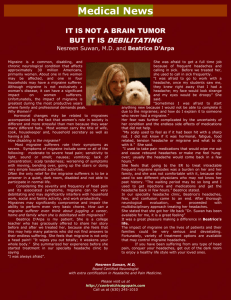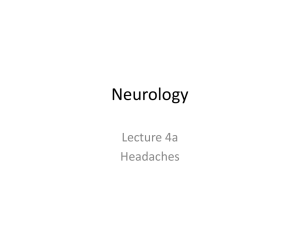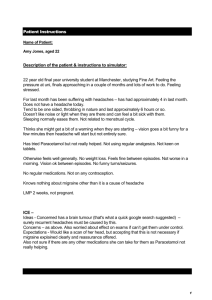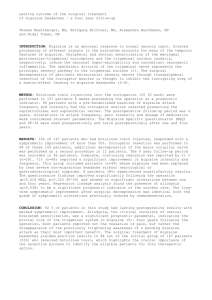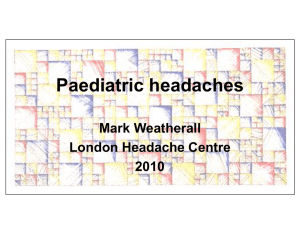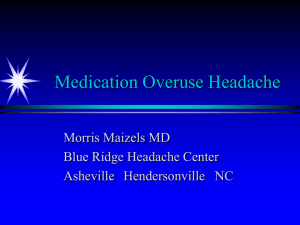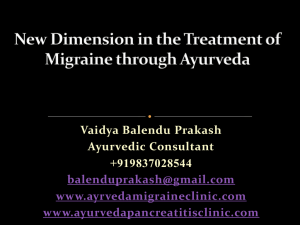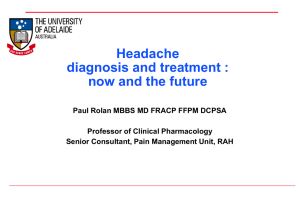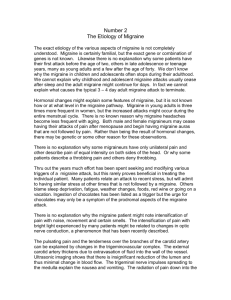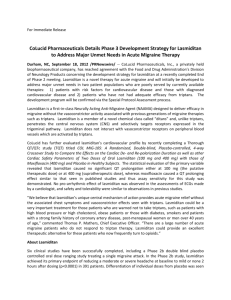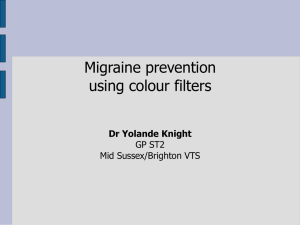Visual Stress Arnold Wilkins University of Essex, UK
advertisement
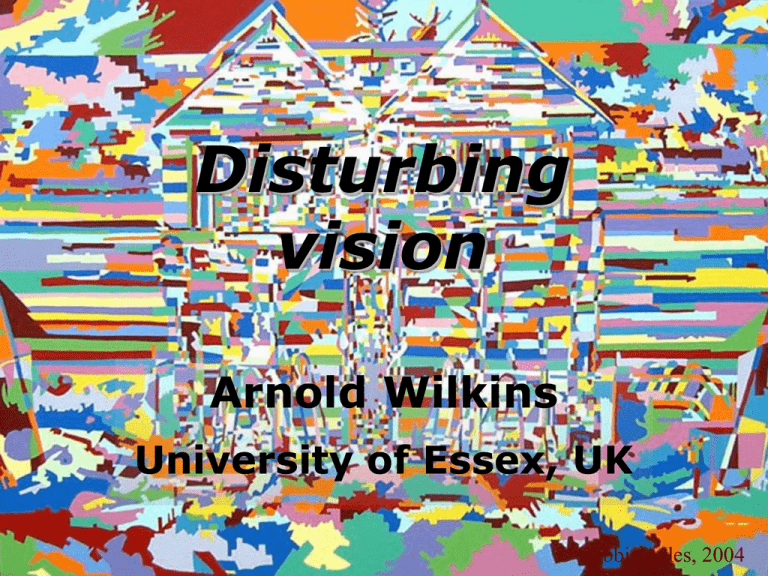
Disturbing vision Arnold Wilkins University of Essex, UK © Debbie Ayles, 2004 A whistle-stop tour Images in nature have a particular spatial structure to which we are adapted. In the modern world images have a different structure and have become “stressful”. This has biological consequences when the visual cortex is hyperexcitable – a variety of neurological symptoms, including headache. Very uncomfortable stimulus In nature there are few spatially repetitive patterns of stripes We have not evolved to process these patterns They are very uncomfortable. I will now show you a very uncomfortable image. ! Very uncomfortable stimulus Images like this are everywhere Here are some examples... Discomfort, illusions and individual differences Stripes and other spatially repetitious stimuli evoke not only discomfort but illusions. There are individual differences in susceptibility. The illusions are related to your headaches. I will now demonstrate this... Perceptual distortion •red •green •blue •yellow •shimmering •flickering •shadowy shapes •blurring Which did you see? •red •green •blue •yellow •shimmering •flickering •shadowy shapes •blurring Headaches and perceptual distortions are related. Headaches 12 or less More than 2 2 or less more than 12 Links between distortions and headaches people who see many distortions have more headaches they see more distortions on days when they have a headache if the headache is on one side of the head the distortions are asymmetric people with migraine dislike the pattern those with aura (warning of headache) see more distortions on the side of the aura Wilkins, A.J. Visual Stress Oxford University Press, 1995 fMRI BOLD Signal Change in V1 (%) Haemodynamic response 4 3 2 1 0 Non-headache controls 0.3 1 3 10 Spatial frequency (cycles/degree) Huang, J. Cooper, T. G. Satana, B. Kaufman, D. I. Cao, Y. (2003). Visual distortion associated with hyper visual neuronal activity in migraine. Headache, 43, 664-671. fMRI BOLD Signal Change in V1 (%) Haemodynamic response 4 3 ** Migraine * 2 Y. 1 0 Non-headache controls 0.3 1 3 10 Spatial frequency (cycles/degree) Huang, J. Cooper, T. G. Satana, B. Kaufman, D. I. Cao, Y. (2003). Visual distortion associated with hyper visual neuronal activity in migraine. Headache, 43, 664-671. Individual differences So the individual differences in susceptibility to illusions from strong patterns may reflect cortical hyperexcitability. . Photophobia from hyperexcitability? Most patients are photophobic during a migraine attack. About 40% of patients with migraine report visual triggers of their migraine. Perhaps flicker and patterns in the environment trigger migraine... Tints in migraine Some patients with migraine report tinted lenses helpful. They do not all choose the same colour. Which tint is best? Intuitive Colorimeter Hue Trial lenses Saturation Green Yellow Orange Brightness Rose 100 transmission (%) Shines coloured light on text Rose Turquoise Blue 0 400 wavelength (nm) Purple 700 Wilkins, A.J., Milroy, R., Nimmo-Smith,I.,Wright, A., Tyrrell, R., Holland, K., Martin, J., Bald, J., Yale, S., Miles, T., Noakes,T. (1992) Preliminary observations concerning treatment of visual discomfort and associated perceptual distortion. Ophthalmic and Physiological Optics, 12, 257-263. Large reduction in activation with precision tint Huang, J., Zong, X., Wilkins, A., Jenkins, B., Bozoki, A. and Cao, Y. (2011). fMRI evidence that precision ophthalmic tints reduce cortical hyperactivation in migraine. Cephalalgia , 31(8), 925-36. Summary Some patients with migraine benefit from tinted lenses The best tint varies from patient to patient Patients with migraine have an abnormally large (fMRI BOLD) and short (NIRS) haemodynamic response to stressful visual stimuli Individually selected tints make the response more normal – decreasing amplitude and lengthening the response Clinical trial What is the effect of tints in clinical practice? Small pilot double–masked trial compared two tints, one that reduced discomfort from patterns and another tint that differed in color by a small amount. Patients did not know which was which. Pilot double-masked placebo-controlled trial Control Lens proportion when control lenses worn Days with symptoms 1 12 0.9 0.8 Log odds p<0.02 0.7 6 0.6 0.5 0.4 0.3 0.2 Precision Tint 0.1 0 0 0.1 0.2 0.3 0.4 0.5 0.6 0.7 0.8 0.9 1 proportion when active lenses worn Wilkins, A.J., Patel, R. Adjamian, R., Evans, B.J.W. (2002). Tinted spectacles and visually sensitive migraine. Cephalalgia, 22, 711-719. Conclusion Environmental stimuli, including text, can be stressful, giving headaches. The individual differences in susceptibility may be associated with an abnormal excitability of the brain. This may be why precision tints can sometimes improve reading speed and reduce discomfort. Precision tints reduce days with symptoms in a small study- we now wish to extend this study to a trial in general practice. Thanks to: Peter Allen John Findlay Ian Nimmo-Smith Liz Ashby Nicola Grayson Tim Noakes Debbie Ayles Sarah Haigh Duncan Nulty John Bald Graham Harding Ragini Patel Tom Beare Gemma Hardy Charlotte Peach Alex Boyd Jie Huang Nirmal Sihra Anne Busby Laura Hughes Anita Simmers Edward Chronicle Stephanie Jainta Jennifer Smith Roanna Cleave Rebecca Jeanes Lianne Smith Chris Cooper Anita Lightstone Lynne Speedwell Louise Coutts Amanda Ludlow Nicola Stevenson Colleen Darby Ann Maclachlan Lynette Taylor John Duffy Judith Martin Ruth Tyrrell Frank Eperjesi Hazel McWhinnie Louise Wilson Bruce Evans Brian Meldrum Wolfgang Jaschinski Marylyn Evans Louise Mell Ben Wright Dominic Fernandez Catherine Neary Sheila Yale Further information Peter Bex Samantha Harper David Pointon www.essex.ac.uk/psychology/overlays/publications2.htm Colin Binnie Pamela Heaton Lorna Scott
